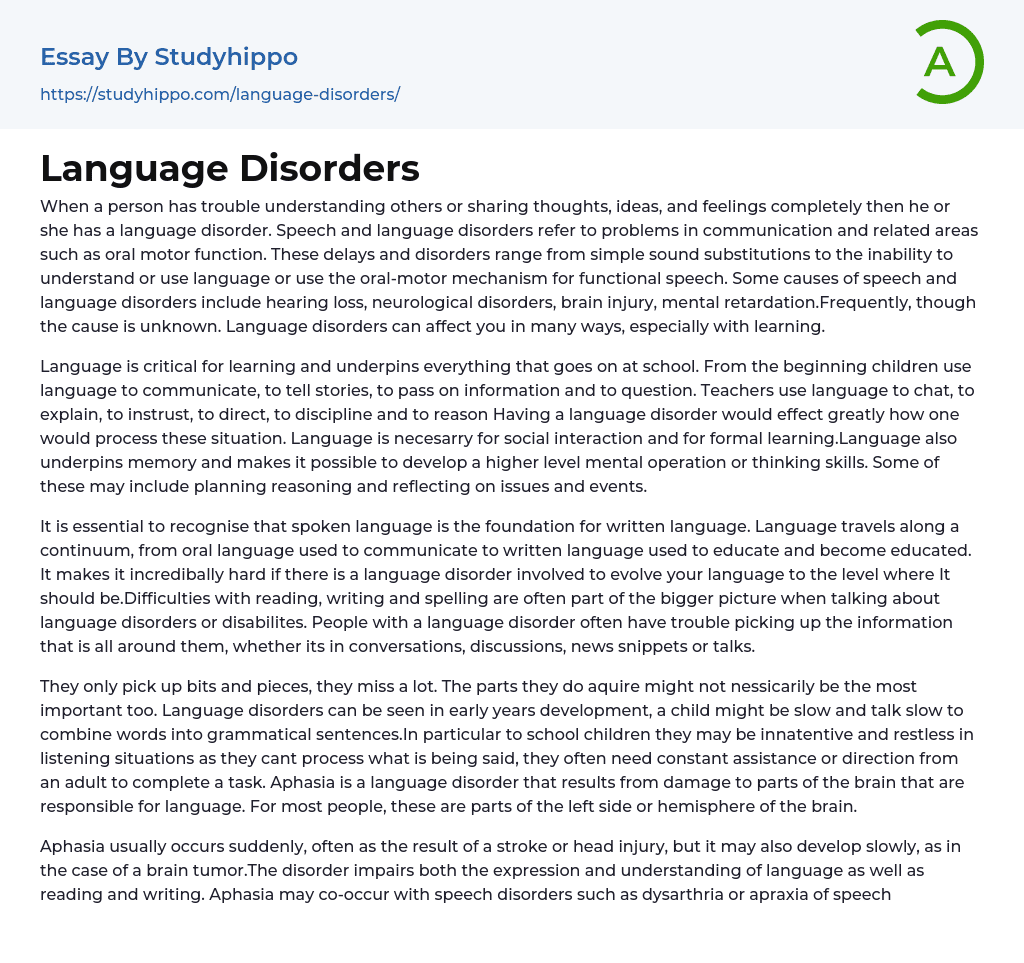A language disorder is identified by the challenges in properly understanding or communicating thoughts, ideas, and emotions. This can include difficulties with oral motor function, which ranges from simple sound substitutions to a complete inability to use or comprehend language or effectively speak. The causes of speech and language disorders may stem from neurological conditions, mental disability, brain trauma, or hearing impairment; however, some cases have no identifiable cause. These disorders can greatly affect learning and various aspects of life.
Language is a crucial element of the educational process, serving as the foundation for all school-related activities. From a young age, children use language to communicate, share information and stories, and ask questions. Teachers also rely on language to engage in discourse with students, clarify concepts, offer guidance, establish boundaries, and encourage logical thinking. If someone were to have a language disorder, it woul
...d severely impact their ability to comprehend these scenarios. Language is vital for social interaction and academic achievement. Moreover, it plays an integral role in memory retention and the development of more advanced cognitive processes such as planning, analyzing and reflecting on various issues and events.
Understanding the importance of spoken language as the foundation for written language is essential, as language follows a continuum from communication through speech to education through writing. Language disorders hinder achieving appropriate linguistic development and often include struggles with reading, writing, and spelling. Those affected by these disorders may have difficulty processing information from everyday conversations, discussions, news items or presentations.
The acquisition of language can be fragmented and incomplete, particularly for those with language disorders that may manifest in slow speech, difficulty with grammar and sentence construction. Suc
disorders may occur during early childhood development or later on in school-aged children who may exhibit signs of restlessness and inattention while processing information. Adult intervention is often required to help these children complete tasks. Aphasia, a language disorder caused by brain damage, affects the left hemisphere responsible for language.
Aphasia, whether sudden due to events like a stroke or head injury or gradual as with a brain tumor, affects language expression and understanding as well as reading and writing abilities. The same brain damage can also result in speech disorders such as dysarthria or apraxia of speech. Broca's aphasia is a form of non-fluent aphasia that specifically involves frontal lobe damage, causing difficulty in speaking short but meaningful phrases with considerable effort. Those with Broca's aphasia may leave out small words like "is," "and," and "the."
An individual suffering from Broca's aphasia can express the desire to walk their dog in a simple statement like "Walk dog," but depending on the situation, this same sentence may have other meanings such as "You take the dog for a walk" or "The dog has walked out of the yard." Although anyone can experience aphasia, it commonly affects people in their mid to later years and impacts their daily activities rather than language comprehension. Since they already possess most essential language skills, communicating with others and conveying their thoughts becomes challenging. Even though aphasia does not lead to complete loss of language, it can affect various aspects of language abilities.
Individuals with impairment usually have brain damage or trauma location linked to it. One kind of impairment is Broca's aphasia, which makes structuring sentences using syntax rules difficult for individuals.
A key feature of this disorder is its agrammatical language, as observed by (Fromkin, Rodman and Hyams), with missing articles like auxiliary verbs, pronouns, and prepositions being common in affected individuals. Another type of aphasia that exists is Wernicke's aphasia.
Individuals with Wernicke's have the ability to speak fluently and with good intonation, although their language may lack semantic coherence. In contrast, those with Broca's may struggle to speak but have better semantic coherence. Severe cases of Wernicke's can result in jargon aphasia. Meanwhile, selective mutism is another language disorder that impacts language acquisition. While capable of understanding and speaking, people with this disorder may not speak in certain social situations where it is expected of them. This can lead to severe withdrawal and anxiety and difficulties participating in group activities despite normal functioning in most areas of behavior and learning.
Dyslexia is a learning disability that impacts the development of writing skills, such as reading and spelling. It differs from other sources of reading challenges and is thought to stem from variances in how the brain handles written or spoken language. Despite being a neurological disorder, dyslexia doesn't impact intelligence and can manifest in individuals with any level of mental capacity. Those with language issues linked to dyslexia frequently experience inadequate academic performance and behavioral difficulties, which may result in leaving school prematurely.
Some students are skilled at concealing their conduct, whereas others can greatly disturb the educational atmosphere.
- Emergence essays
- Anxiety Disorder essays
- Post-traumatic Stress Disorder essays
- Public Speaking essays
- Freedom Of Speech essays
- Free Speech essays
- Persuasive Speech essays
- Gettysburg Address essays
- Informative Speech essays
- Arranged Marriage essays
- Communication essays
- Conflict Management essays
- Conflict Resolution essays
- Connection essays
- Conversation essays
- Dating essays
- Friendship essays
- Mediation essays
- Addiction essays
- Anatomy and Physiology essays
- Biodegradation essays
- Cancer essays
- Dental Care essays
- Disability essays
- Disease essays
- Disorders essays
- Health Care essays
- Infectious Disease essays
- Inquiry essays
- Intelligence Quotient essays
- Lung Cancer essays
- Medicine essays
- Neurology essays
- Nutrition essays
- Olfaction essays
- Physical Exercise essays
- Public Health essays
- Sex essays
- Women's Health essays
- World health organization essays
- Adhd essays
- Antisocial Personality Disorder essays
- Anxiety essays
- Bipolar Disorder essays
- Depression essays
- Depression And Anxiety essays
- Dyslexia essays
- Learning Disability essays
- Major Depressive Disorder essays
- Mental Disorder essays




